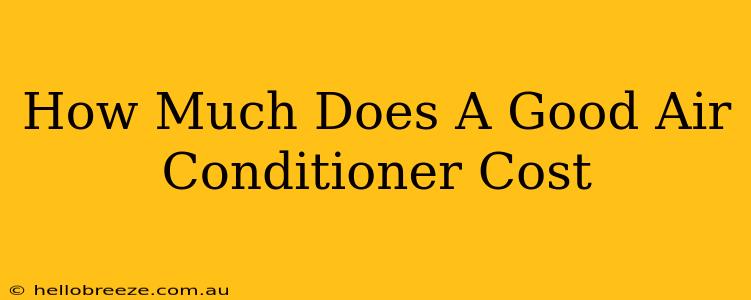Summer's heat can be unbearable, making a reliable air conditioner a necessity for many. But how much should you expect to pay for a good AC unit? The cost varies significantly depending on several factors, and understanding these is crucial before you buy. This comprehensive guide will break down the price ranges, influencing factors, and help you make an informed decision.
Factors Affecting Air Conditioner Costs
Several key elements influence the overall cost of an air conditioner. These include:
1. Type of Air Conditioner:
- Window Units: These are the most budget-friendly option, typically ranging from $100 to $500. However, their cooling capacity is often limited, and they're less energy-efficient than other types.
- Portable Air Conditioners: Offering more flexibility than window units, portable ACs cost between $300 and $1000, depending on features and cooling power. They are generally less efficient than central or ductless systems.
- Central Air Conditioners: These systems are installed within your home's ductwork and offer whole-house cooling. They are the most expensive upfront, ranging from $3,000 to $10,000+, depending on the size of your home and the features included.
- Ductless Mini-Split Systems: A great option for zoning and adding cooling to areas without existing ductwork, these units cost $1,000 to $5,000+ per unit, depending on size and features. Installation costs can also significantly add to the price.
2. Size and Cooling Capacity (BTUs):
The larger the space you need to cool, the higher the BTU (British Thermal Unit) rating your AC unit needs. Higher BTU ratings mean higher costs. Always calculate the correct BTU requirement for your space to avoid overspending or underperforming.
3. SEER Rating (Seasonal Energy Efficiency Ratio):
A higher SEER rating indicates a more energy-efficient unit. While higher SEER units have a higher upfront cost, the long-term savings on energy bills often make them a worthwhile investment. Look for units with a SEER rating of 14 or higher.
4. Features and Brands:
Features like smart home integration, programmable thermostats, and advanced filtration systems increase the price. Established brands often command higher prices than lesser-known ones, but they frequently offer better warranties and performance.
5. Installation Costs:
Installation costs can significantly impact your overall budget. Central AC systems and ductless mini-splits require professional installation, adding $1,000 to $5,000+ to the overall cost. Window and portable units are typically easier to install yourself, saving on labor costs.
Cost Breakdown Examples:
- Budget-Friendly Option: A small window AC unit might cost $150-$300, plus a small installation fee if needed.
- Mid-Range Option: A portable AC with decent features could cost $500-$800.
- High-End Option: A central AC system for a large home could cost $6,000-$12,000+, including professional installation.
Tips for Saving Money:
- Shop around and compare prices: Get quotes from multiple vendors before making a decision.
- Consider energy-efficient models: The long-term savings on energy bills can offset the higher upfront cost.
- Look for rebates and incentives: Many utility companies offer rebates on energy-efficient appliances.
- DIY installation (if possible): Installing a window or portable unit yourself can save on labor costs.
- Consider financing options: Some retailers offer financing plans to make large purchases more manageable.
Conclusion:
The cost of a good air conditioner can range from a few hundred dollars to over ten thousand. The best option for you depends on your individual needs, budget, and the type of unit you choose. By carefully considering the factors discussed above, you can make an informed decision and choose an air conditioner that provides comfortable cooling without breaking the bank. Remember to factor in installation costs and energy efficiency when making your final selection.

